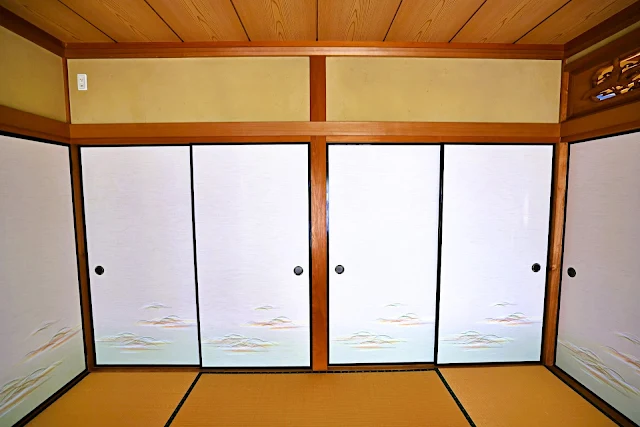
Japanese culture is renowned for its unique blend of aesthetics and functionality, and one prime example of this can be seen in the traditional sliding doors known as Fusuma.
These exquisite doors not only serve as practical room dividers but also showcase the artistic mastery and cultural significance of Japan.
In this article, we will delve into the rich history, craftsmanship, and cultural importance of Fusuma, exploring their origins, construction, and the role they play in Japanese architecture and design.
{tocify} $title={Table of Contents}
Origins and Evolution
The roots of Fusuma can be traced back to ancient Japan, where they were initially used as shōji (障子) or "barrier screens" made of wooden frames covered with paper or cloth.
The term "Fusuma" emerged later as a distinctly Japanese name for these sliding doors.
According to historical accounts, Fusuma was first devised during the Heian period (794-1185) and gained popularity as room dividers in the sleeping quarters of the Imperial Palace.
Originally referred to as "fusuma shōji" or "karakami shōji," they were eventually simply called "karakami" or "Fusuma."
The etymology of the term "Fusuma" is believed to have derived from the word "衾" (fusuma), meaning "bedding" or "covering."
The initial form of Fusuma consisted of wooden boards covered with silk fabric.
Over time, these boards were improved by adding vertical and horizontal bars to create a lightweight structure.
Eventually, this innovation led to the development of sliding doors, transforming the traditional shōji into the elegant and functional Fusuma seen today.
Construction and Components
Fusuma is constructed using a combination of various materials and components.
Let's explore each of these elements that contribute to the creation of these remarkable sliding doors:
Frame
The foundation of Fusuma is a sturdy wooden frame known as "kamachi."
This frame provides structural support and stability to the door.
Typically made from a high-quality wood such as hinoki (Japanese cypress), the frame is meticulously crafted to ensure durability and longevity.
Covering
The covering of Fusuma is traditionally made from washi, a type of Japanese paper.
This paper is carefully pasted onto the frame, creating a smooth and elegant surface.
The use of washi allows soft, diffused light to pass through while maintaining privacy within the room.
Handles
Fusuma feature handles, known as "hiki-te," are used to open and close the doors.
These handles not only serve a functional purpose but also add aesthetic accents to the overall design of the Fusuma.
In ancient times, handles were made of leather, strings, or metal attachments.
However, during the Azuchi-Momoyama period (1568-1600), decorative handles made of various materials such as metal, wood, and porcelain were introduced, showcasing intricate designs and craftsmanship.
Cultural Significance
Fusuma not only serve as practical room dividers but also hold deep cultural significance in Japanese society.
These sliding doors have been an integral part of traditional Japanese architecture for centuries, reflecting the country's unique values and aesthetics.
Let's explore some of the cultural aspects associated with Fusuma:
Japanese Interior Design
Fusuma play a crucial role in Japanese interior design, enabling flexible and customizable spaces within a room.
The ability to slide open or close the doors allows for the creation of private areas, the rearrangement of living spaces, and the adaptation of rooms to suit different occasions and needs.
This versatility exemplifies the Japanese concept of ma, which focuses on the harmonious use of space.
Tatami Rooms and Fusuma
Fusuma is commonly used in washitsu (traditional Japanese-style rooms) that feature tatami flooring.
These rooms are designed to create a serene and calming atmosphere, emphasizing simplicity and natural elements.
Fusuma serves as the ideal room dividers, allowing for the transformation of large spaces into smaller, more intimate areas.
Additionally, Fusuma are often adorned with fusuma-e, traditional paintings or designs, adding an artistic touch to the overall ambiance of the room.
Artistic Expression
Fusuma provide a canvas for artistic expression, with many doors adorned with intricate paintings or designs known as fusuma-e or fusuma-ga.
These paintings often depict scenes from nature, mythological figures, or daily life in Japan.
Renowned artists such as Kanō Eitoku and Kanō Sanraku were commissioned to create stunning Fusuma paintings during the Momoyama period (1573-1603), showcasing their exceptional skills and creativity.
Maintenance and Care
To ensure the longevity and beauty of Fusuma, proper maintenance and care are essential.
Here are some tips for maintaining these exquisite sliding doors:
- Regular Cleaning: Dusting the surface of Fusuma with a soft cloth or feather duster helps keep them clean and free from dirt or debris.
- Avoid Moisture: Fusuma are susceptible to moisture damage, particularly the paper covering. It is essential to keep them away from areas with high humidity or excessive moisture.
- Protect from Direct Sunlight: Prolonged exposure to direct sunlight can cause the paper covering to fade or become brittle. Using curtains or blinds can help protect Fusuma from harsh sunlight.
- Professional Restoration: In case of damage or deterioration, it is advisable to seek professional restoration services to preserve the integrity and beauty of Fusuma.
Japanese Fusuma are more than just practical room dividers; they represent the fusion of art, functionality, and cultural significance.
From their origins as simple wooden frames covered with silk fabric to the intricate and breathtaking designs seen today, Fusuma exemplifies the craftsmanship and attention to detail that is deeply ingrained in Japanese culture.
As we appreciate these sliding doors, we also gain a deeper understanding of the unique aesthetics and timeless appeal of Japanese architecture.
So, let us embrace the elegance of Fusuma and immerse ourselves in the fascinating world they create within Japanese interiors.

Your Gateway to Japan's Wonders! Immerse yourself in the beauty, culture, and adventures that Japan has to offer.
Check It Out!
Post a Comment